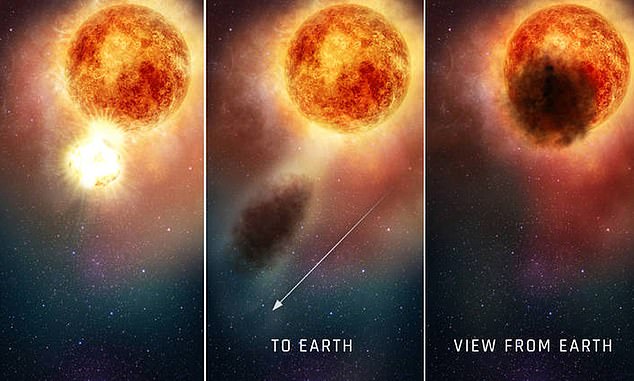One of the brightest stars in the night sky will ‘blink out’ NEXT WEEK – and YOU can watch this ‘extremely rare’ red sun eclipse happen
One of the brightest stars in the sky will disappear next week in an “extremely rare” event that will be visible in parts of the United States, astronomers report.
Betelgeuse, the orange-red star among the stars that make up the Orion constellation, appears to disappear for 12 seconds on the night of Monday, December 11, when it is briefly obscured by an asteroid.
While asteroids pass between Earth and the stars all the time, the rarity of Monday's event stems from 319 Leona's collision with a brilliant blob that will leave a visible “ring of fire” around Betelgeuse.
Locals in Florida, as well as parts of eastern Mexico, southern Europe and northern Asia, will be in the perfect line of sight to see the David Copperfield star's fading process, as the giant star is briefly obscured by asteroid 319. Leona – Monday night, December 11
Locals in Florida, as well as parts of eastern Mexico, southern Europe and northern Asia, will be in an ideal viewing range to see it.
But for everyone else, Betelgeuse's rare “occlusion” will be visible via a live stream, hosted by the Virtual Telescope Project in Italy, starting at 8 p.m. ET on Monday.
Although time will be of the essence during this 12-second window, astronomers hope to observe the sky more seriously, using the cap to map the Sun's giant red surface, which has undergone a strange dimming over the past four years.
'This is very exceptional. Essentially, it's a once-in-a-lifetime opportunity, said astrophysicist Miguel Montargis of the Paris Observatory. Interested in trade.
For ground-based observatories, these hot, charged gases would be drowned out by the stunning glow coming from the center of Betelgeuse, according to Montargis.
The eclipse-like “occlusion” will help stellar astrophysicists collect imaging data from the surface of Betelgeuse to understand what are known as red supergiant convection cells: the paths by which hot gas moves around the star.
Montargis predicted that the data collected might help physicists improve their models of how a planetary system, like our solar system, is born.
Astrophysicist Gianluca Masi, Director Virtual telescope project Which will Live broadcast of the celestial eventHe noted that this rare event will also help scientists study 319 lions as well.
“This type of masking is very useful for constraining the shape of the asteroid in question,” Massey said in a statement.
but. Massey added that the occultation event is not only “extremely rare” but a harbinger of Betelgeuse's future.
“For a very short time, we will see the legendary constellation Orion without its famous orange shoulder, as it will in the distant future, once Betelgeuse explodes as a supernova and fades to black,” Massey wrote.

In recent years, astronomers have captured never-before-seen images of Betelgeuse's surface, allowing them to track changes in real time and determine whether “this sudden dimming is caused by the formation of stardust.” Monday's close will provide more evidence

The “occlusion” will help stellar physicists collect data from the surface of Betelgeuse to better understand why it has dimmed in recent years. Andrea Dupre of Harvard's Center for Astrophysics suggested that the dimming was due to a massive dust cloud (shown above).
Astronomers and astrophysicists will be trying to calculate and predict the path of asteroid 319 Leona until the last minute, but according to Sky & Telescope, the occultation is now likely to occur around 8:17 PM ET.
Skywatchers within the right line of sight will be able to see Betelgeuse, usually the tenth brightest star in the night sky, disappearing with their naked eyes.
But binoculars or a telescope will of course help enhance the experience of viewing the rare occlusion event.
Those interested in other parts of the world may still want to make the attempt, and will likely see more of Betelgeuse appearing unusually faint.
Northern Hemisphere residents looking to find Betelgeuse in December should start looking east about two hours after sunset — the feature should help them see the rising of Orion's Belt, and the stars Alnitak, Alnilam, and Mintaka, along with Betelgeuse. Glowing orange Gemini. To their left.
For more information, the International Conjunction of Occult Timing has Information page dedicated to this event Using a downloadable Google Earth file to help track where the event will be seen around the world.
(Tags for translation)dailymail
